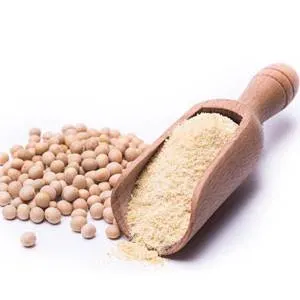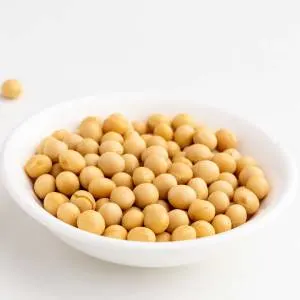 Traditional wheat flour is the most common ingredient in baked goods, but if you don’t like or can’t tolerate wheat, an alternative is needed. Soy flour is often used as an alternative, but what is a good soy flour substitute?
Traditional wheat flour is the most common ingredient in baked goods, but if you don’t like or can’t tolerate wheat, an alternative is needed. Soy flour is often used as an alternative, but what is a good soy flour substitute?
This post explores some of the many delicious and healthy soy flour alternatives available to make delicious and healthy food, such as oatmeal muffins and banana bread.
There are a lot of substitutes for soy flour, which is a common ingredient in gluten-free baking. I want to share some of my favorites with you and why they’re great alternatives.
Read More: Best Blender for Making Flour: 3 Powerful Models
What is Soy Flour?
Soy flour is made from ground soybeans. It is a high-protein, low-carbohydrate flour that is gluten-free. Soy flour is used as a thickener and to give foods a chewy texture. It is also high in fiber, vitamins, and minerals.
Why Soy Flour is a Good Choice
Soy flour is a good choice for people with gluten sensitivities or allergies, as well as those who are trying to reduce their carbohydrate intake. Soy flour is also rich in protein, which makes it a good choice for vegetarians and vegans.
The Downside of Soy Flour
There are some potential downsides to using soy flour. Soy flour can be hard for the body to digest, due to the trypsin inhibitor still present. For this reason, soy flour may not be a good choice for people who have digestive issues.
Additionally, some people find the taste of soy flour bitter and unpleasant.
Why Use a Soy Flour Substitute?
Wheat flour is the most common type of flour in the United States, but it’s not the only one. There are many different types of flours including almond, rice, buckwheat, and corn.
If you’re looking for a soy flour substitute because you’re intolerant to gluten or wheat, there are plenty of other options available.
Rice Flour
Rice flour is a good substitute for soy flour. It has a mild, almost neutral flavor that means it can be used in many different types of dishes.
Rice flour is also much lower in fat than soy flour, which makes it better if you want to avoid too many calories or saturated fats.
It’s also naturally gluten-free and does not contain any wheat, making it a safe option for people with celiac disease or wheat allergies.
Read More: Grinding Wheat Berries in a Vitamix Blender: How Easy Is It?
Almond Flour
Many people who are intolerant to gluten and/or wheat find that they can eat almonds without an issue. Almond flour is made from ground, blanched almonds and contains no dairy products like some other nut pastes do.
Because the flour is made from almonds, it has a rich source of protein and healthy fats. It can also be used to make gluten-free bread, muffins, pancakes, crackers, flourless cakes/cupcakes, etc.
Buckwheat Flour
Buckwheat flour is another grain-based flour that you can use as an alternative to soy flour. Buckwheat does not contain any wheat or gluten and is safe for people with celiac disease or allergies to wheat.
One of the biggest benefits of using buckwheat flour as a substitute for soy flour is that it has a sweet taste that very closely resembles traditional baking ingredients like white sugar. This sweet flavor makes it perfect for making baked goods such as bagels, pancakes, waffles, and cookies.
Corn Flour
Corn flour is a great gluten-free option for those looking for a soy flour substitute. It is made from ground corn and has a mild flavor that makes it perfect for use in a variety of dishes.
Like rice flour, corn flour is low in fat and calories, making it a good choice if you’re trying to reduce your intake. It also contains high levels of vitamins and minerals like thiamin, niacin, and magnesium.
Coconut Flour
Coconut flour is made from dried, ground coconut. It is a high-fiber flour that is gluten-free and low in carbohydrates.
One of the biggest benefits of coconut flour is that it absorbs a lot of liquid. This makes it perfect for replacing eggs or other binders in recipes.
Coconut flour also has a sweet, nutty flavor that makes it a great choice for desserts and baked goods. Just don’t use too much of it or it may change the taste of your dish.
Read More: Making Pie Crust In Vitamix: Tips And Tricks
Chestnut Flour
Chestnut flour is a lesser-known flour that can be used as a soy flour substitute. It is made from ground chestnuts and has a sweet, nutty flavor.
Chestnut flour is also high in fiber, antioxidants, and vitamins B1 and B6. It can be used to make bread, pasta, dessert recipes, and more.
Chickpea Flour
Chickpea flour, also known as besan, garbanzo bean flour, or gram flour, is a common gluten-free, high fiber ingredient in Indian cooking. It can be used to substitute soy flour when baking or cooking.
Just keep in mind that it’s quite dense in comparison to other flours so you’ll need to use less of it. The taste also has a slightly sour flavor that makes it perfect for savory dishes but not ideal for sweet desserts.
Quinoa Flour
Quinoa flour is a grain-free, gluten-free option that can be used as a soy flour substitute. It is made from ground quinoa and has a light, fluffy texture.
Quinoa flour is also high in protein, fiber, antioxidants, and vitamins B and E. It can be used to make bread, muffins, pancakes, waffles, cookies, and more.
Lupin Flour
Lupin flour is made from ground, dehulled lupin seeds and contains no gluten or wheat. It can be used as a soy flour substitute in baking and cooking.
However, you should note that it has a strong taste and smell, which makes it best for savory dishes like pasta and pizza crusts.
Water Chestnut Starch
Water chestnut starch is made from ground water chestnuts and is a great gluten-free option for those looking for a soy flour substitute. It has a neutral taste and can be used in most recipes that call for a thickening agent.
One downside to water chestnut starch is that it is slightly grey in color, so it may alter the look of your dish.
What is Wrong with Soy Flour?
 You may be wondering, what is wrong with soy flour?
You may be wondering, what is wrong with soy flour?
Soy products have gotten a bad reputation in the past few decades for being unhealthy and causing digestive issues. Here are some of the main reasons why you may want to avoid soy products:
- Isoflavones. Isoflavones are estrogen-like compounds that can mimic natural estrogens in your body. Studies suggest that this can cause hormonal changes over time, leading to early puberty, menstrual cycle irregularities, fertility problems, and more.
- Phytic Acid. Soy products also contain high levels of phytic acid which promotes tooth decay by trapping minerals like calcium and zinc in your mouth during digestion.
- Soy Allergies. One of the most alarming health issues is soy allergies. Soy allergies are one of the top eight food allergies in the world, affecting millions of people each year.
- High GMO Risks. Genetically modified soybeans have also been linked to high risks for cancer due to their pesticide content and the potential link with infertility by causing hormone imbalances over time.
How Do You Make Soy Flour?
Soy flour is made from soybeans that have been steamed, dried, and defatted. The beans are ground into a coarse meal before being sifted to separate the bran and germ from the endosperm.
This creates a lower fat content in soy flour, which has a higher carbohydrate concentration with a smaller amount of protein. It also takes on a slightly nutty taste with a beige to yellow color depending on its level of refinement.
How Do You Know If You Are Soy Intolerant?
If you suspect that you have a soy allergy or intolerance, it’s a good idea to talk with your doctor first before cutting out soy products entirely. This is especially important if you have other conditions such as hypothyroidism, diabetes, or cancer.
While avoiding soy-free diets may seem like the best solution to minimizing your risk for exposure, eliminating an entire food group can be difficult and even dangerous depending on your health concerns.
However, if you notice any signs of discomfort after eating these foods including gas or bloating, constipation or diarrhea, nausea or vomiting, fatigue, and headache, then it might be time to cut back on soy and see how it impacts your condition over time.
Soy Flour Substitute: Final Thoughts
In this post, I’ve shared some of my favorite soy flour substitutes that are delicious and healthy options for people who want to bake gluten-free. If you don’t like or can’t tolerate wheat, these alternatives will be perfect for you.
Whether it’s muffins or banana bread, following the tips in this article will help make your baked goods taste better while also being healthier.
I hope you enjoyed this recipe for gluten-free soy flour substitutes. I also hope that it helps make your transition to a soy-free diet a little bit easier!
Please feel free to share this with your friends and family who might need help cutting out soy from their diets.
